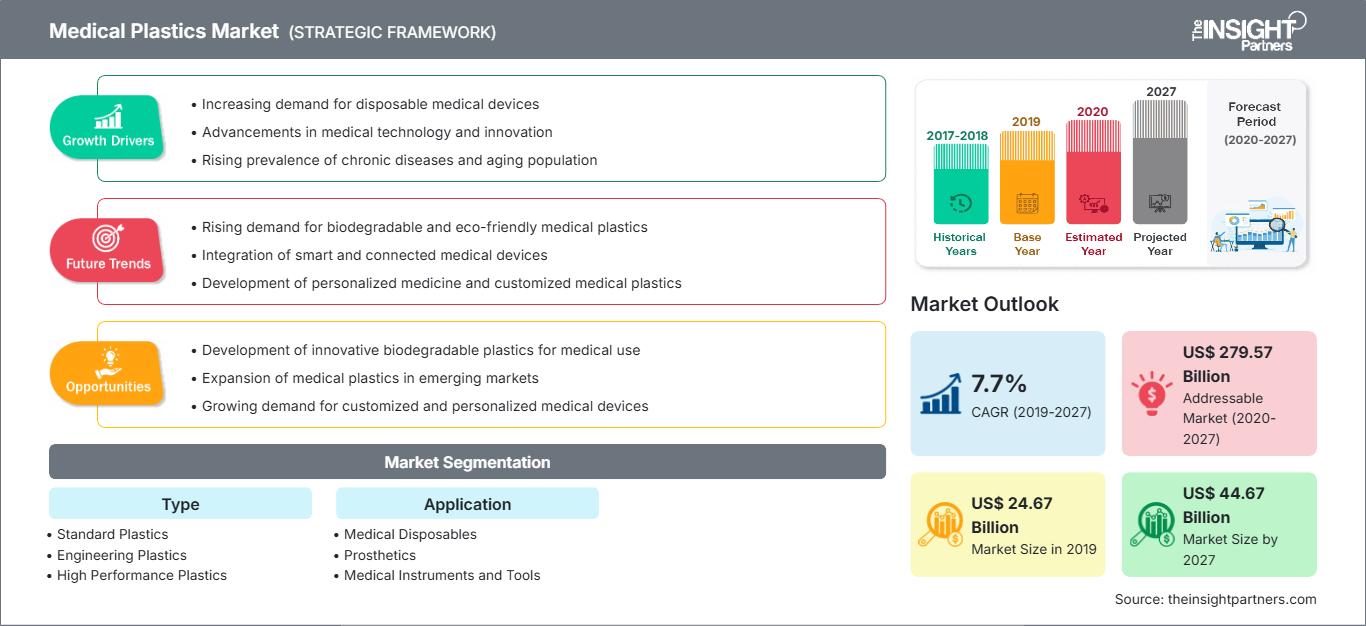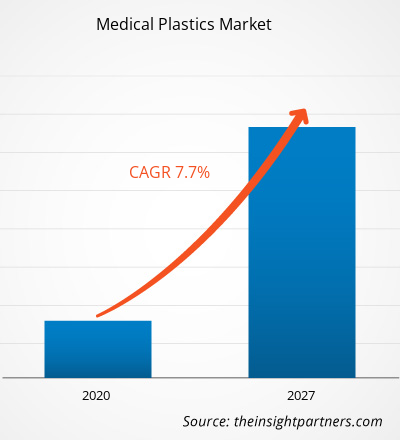El mercado de plásticos médicos se valoró en US$ 24.671,82 millones en 2019 y se proyecta que alcance los US$ 44.669,63 millones para 2027; se espera que crezca a una CAGR del 7,7% de 2020 a 2027.
Los plásticos médicos se fabrican a partir de una gran cantidad de macromoléculas. Estos plásticos se utilizan para producir instrumentos consistentes y seguros en la industria sanitaria. Son notablemente duraderos, flexibles y económicos. El rendimiento, la esterilidad y la calidad de los dispositivos médicos son un factor clave para la expansión del mercado. Los plásticos médicos encuentran una amplia gama de aplicaciones en instrumentos de diagnóstico, implantes, productos desechables, dispositivos de administración de fármacos, instrumental quirúrgico, jeringas y catéteres. Se prevé que la población mundial aumente en los próximos años. Con el aumento de la población, las enfermedades e infecciones se propagan de forma desenfrenada a través de diversos medios. El aumento de la población geriátrica impulsa aún más el desarrollo del sector sanitario.
Se prevé que el mercado global de plásticos médicos en Asia Pacífico crezca a una tasa de crecimiento anual compuesta (TCAC) del 8,4 % durante el período 2020-2027. El rápido crecimiento del mercado en esta región se atribuye principalmente a la creciente demanda de plásticos médicos debido a sus aplicaciones en desechables médicos, prótesis, instrumentos y herramientas médicos, y administración de fármacos.
El reciente brote de COVID-19, que comenzó en Wuhan, China, en diciembre de 2019, se ha extendido rápidamente por todo el mundo. En junio de 2020, Estados Unidos, Rusia, India, China, Italia, Francia y Alemania se encontraban entre los países más afectados en cuanto a casos positivos y fallecimientos. Según las cifras de la OMS actualizadas en junio de 2020, se habían reportado aproximadamente 7.482.952 casos confirmados y aproximadamente 419.497 fallecimientos a nivel mundial. El brote ha afectado a las economías e industrias debido a los confinamientos, las prohibiciones de viaje y el cierre de negocios decretados en varios países. El sector de productos químicos y materiales es una de las principales industrias del mundo. Está sufriendo graves interrupciones, como interrupciones en la cadena de suministro, cancelaciones de eventos tecnológicos y cierres de oficinas, como resultado de este brote. China es el centro mundial de fabricación y el mayor proveedor de materias primas para diversas industrias. La suspensión de varias plantas y fábricas en China está afectando las cadenas de suministro globales y perjudicando la fabricación y venta de diversos productos químicos y materiales. El colapso general del mercado debido a la pandemia de COVID-19 también está afectando el crecimiento del mercado mundial de plásticos médicos.
Personalice este informe según sus necesidades
Obtendrá personalización en cualquier informe, sin cargo, incluidas partes de este informe o análisis a nivel de país, paquete de datos de Excel, así como también grandes ofertas y descuentos para empresas emergentes y universidades.
Mercado de plásticos médicos: Perspectivas estratégicas

-
Obtenga las principales tendencias clave del mercado de este informe.Esta muestra GRATUITA incluirá análisis de datos, desde tendencias del mercado hasta estimaciones y pronósticos.
Perspectivas del mercado
Numerosas ventajas que ofrecen los plásticos en los dispositivos médicos favorecen el crecimiento del mercado a nivel mundial
Jeringas de plástico desechables, válvulas cardíacas nuevas, bolsas de sangre y diversos dispositivos médicos están fabricados con plástico. Para contrarrestar la creciente preocupación por el Staphylococcus aureus resistente a la meticilina y otros similares, se han desarrollado polímeros de alta tecnología, infecciones por estafilococos de transmisión hospitalaria y plásticos antimicrobianos. Estos plásticos repelen y eliminan la mayoría de las bacterias, incluso en superficies de alto contacto, y previenen infecciones. Además, los plásticos antimicrobianos tienen una alta eficacia en la eliminación de bacterias incluso cuando las superficies no se limpian con regularidad. De esta manera, el uso de polímeros de alta tecnología y plásticos antimicrobianos en dispositivos médicos ayuda a reducir el riesgo de enfermedades en los pacientes. Gracias a su alta resistencia al impacto y estabilidad térmica, los plásticos de ingeniería están reemplazando ampliamente a la madera o a cualquier otro material utilizado como mango de instrumental quirúrgico. Además, requieren menos mantenimiento y una esterilización menos frecuente. Los fabricantes están cambiando la madera y el metal por plásticos de ingeniería como el POM debido a su rendimiento superior, bajo precio, propiedades no higroscópicas y buena maquinabilidad.
Perspectivas de la aplicación
Según su aplicación, el mercado de plásticos médicos se segmenta en desechables médicos, prótesis, instrumental médico, administración de fármacos, entre otros. Este segmento representó la mayor participación del mercado global en 2019. Los plásticos se han utilizado ampliamente para crear instrumental médico, como jeringas, guantes quirúrgicos, plumas de insulina, catéteres, sondas intravenosas y dispositivos inflables. Estos productos se fabrican para un solo uso y ayudan a prevenir la propagación de enfermedades peligrosas al eliminar la necesidad de reutilizar o esterilizar un dispositivo. Los plásticos también se utilizan para crear superficies táctiles antimicrobianas superiores que pueden repeler microbios y otras bacterias, disminuyendo así la propagación de enfermedades peligrosas.
Perspectivas regionales del mercado de plásticos médicos
Los analistas de The Insight Partners han explicado detalladamente las tendencias regionales y los factores que influyen en el mercado de plásticos médicos durante el período de pronóstico. Esta sección también analiza los segmentos y la geografía del mercado de plásticos médicos en América del Norte, Europa, Asia Pacífico, Oriente Medio y África, y América del Sur y Central.
Alcance del informe del mercado de plásticos médicos
| Atributo del informe | Detalles |
|---|---|
| Tamaño del mercado en 2019 | US$ 24.67 mil millones |
| Tamaño del mercado en 2027 | US$ 44.67 mil millones |
| CAGR global (2019-2027) | 7,7% |
| Datos históricos | 2017-2018 |
| Período de pronóstico | 2020-2027 |
| Segmentos cubiertos |
Por tipo
|
| Regiones y países cubiertos |
América del norte
|
| Líderes del mercado y perfiles de empresas clave |
|
Densidad de actores del mercado de plásticos médicos: comprensión de su impacto en la dinámica empresarial
El mercado de plásticos médicos está creciendo rápidamente, impulsado por la creciente demanda del usuario final debido a factores como la evolución de las preferencias de los consumidores, los avances tecnológicos y un mayor conocimiento de los beneficios del producto. A medida que aumenta la demanda, las empresas amplían su oferta, innovan para satisfacer las necesidades de los consumidores y aprovechan las tendencias emergentes, lo que impulsa aún más el crecimiento del mercado.

- Obtenga una descripción general de los principales actores clave del mercado de plásticos médicos
Mercado de plásticos médicos, por tipo
- Plásticos estándar
- Plásticos de ingeniería
- Plásticos de alto rendimiento (HPP)
- Silicona
- Otros
Mercado de plásticos médicos por aplicación
- Desechables médicos
- Prótesis
- Instrumentos y herramientas médicas
- Administración de medicamentos
- Otros
Perfiles de empresas
- Corporación Celanese
- Compañía química Eastman
- Plásticos GW
- Orthoplastics Ltd
- TEORANTA BIOMÉDICA DE ARAN
- Rochling
- SABIC
- Saint-Gobain
- Solvay
- Dow
- Análisis histórico (2 años), año base, pronóstico (7 años) con CAGR
- Análisis PEST y FODA
- Tamaño del mercado, valor/volumen: global, regional y nacional
- Industria y panorama competitivo
- Conjunto de datos de Excel
Informes recientes
Informes relacionados
Testimonios
Razón para comprar
- Toma de decisiones informada
- Comprensión de la dinámica del mercado
- Análisis competitivo
- Información sobre clientes
- Pronósticos del mercado
- Mitigación de riesgos
- Planificación estratégica
- Justificación de la inversión
- Identificación de mercados emergentes
- Mejora de las estrategias de marketing
- Impulso de la eficiencia operativa
- Alineación con las tendencias regulatorias






















 Obtenga una muestra gratuita para - Mercado de plásticos médicos
Obtenga una muestra gratuita para - Mercado de plásticos médicos